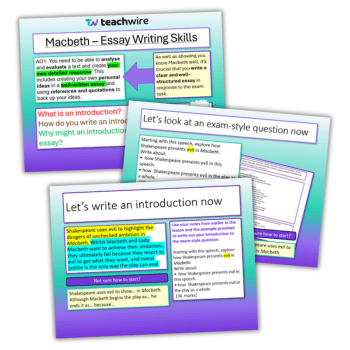Model sentences – Use them to liberate your students’ writing skills

Model sentences and paragraphs aren’t there to be copied; they’re there to give your students agency and show them what’s possible, writes Elaine McNally

The model paragraph had taken some time to plan. In the lesson, I wrote for attentive students – narrating my decisions, explaining my analysis. The lesson looked like it was going well. And then…
‘Over to you,’ I declared. ‘Your turn to write. Use my model as an example.’ Yet, instead of eager industry, I got blank stares and the dismayed, wailing chorus of ‘I don’t know what to write!’
Sound familiar? Just because we have modelled a piece of writing doesn’t mean students can replicate that writing in another context.
Disciplinary thinking
What are we are trying to achieve with that model paragraph? When we write for students, we’re not modelling a neat process that results in a consistent outcome. In English, answers are varied. Your paragraph will be different to mine.
When we model writing, we’re really modelling thought. Writing is merely the vehicle that delivers thought. Communicating this, and showing students the disciplinary thinking that underpins our writing choices, will help them understand how to apply what they’re shown in great writing of their own.
So how do we model thinking to students in the classroom? How do we train students in disciplinary thinking so that their outcomes in English improve and they move to a place of independence? Three strategies can help – questions, sentences and finding spaces.
Model asking questions
Academic writing is a response to questions, but for skilled writers, those questions have become automated to the point of invisibility. When you model the process of writing, show students how to approach a task by asking questions.
This way, they can learn that writing isn’t a mystery they can’t access, but just answers to questions they can learn to ask. Students think they have to learn the answers, which isn’t true. In English, answers are subjective, personal, different. Students have to learn the trick of asking questions, and understand that they shape an answer with their own interrogations.
Questions that begin with ‘What?’ ‘How?’ and ‘Why?’ are crucial. ‘So what?’ has huge utility. These questions open gates to ideas in the text, and replicate how a literary critic thinks. Model how to reframe an essay title as a series of questions. Students can then learn how to generate their own questions and answers, leading to a personalised argument that has a structure.
However, the best question to model for exposing the conceptual thinking behind writing, is ‘If…then what?’ Sometimes, we might ask questions that are text-dependent without signalling why we’re asking those questions in the first place. Ultimately, I don’t want them to latch onto points made about Mr Birling from asking ‘What do we learn about Mr Birling in Act 1?’ I do want them to hear the question, ‘If character is a vehicle for the text’s themes, then what do we learn about Mr Birling in Act 1?’ or, ‘If the motif of light is used to signify revelation throughout the novel, then what is the significance of light in this extract?’
I want them to understand what shapes my question about an aspect of a text, and how that in turn shapes the response I write.
‘If…then what’ questions foreground the conceptual knowledge that hides behind local comprehension. You’re going in small (because the question is precise), but also large (since the ‘if’ part works broadly for any text).
Although you’ll ask local, context-specific questions that generate content, when you’re modelling writing, aim to explicitly foreground conceptual thinking. Modelling ‘If…then what’ questions and the answers they generate shows students that knowledge is connected, and that writing comes from those interconnections.
Ultimately, we want students to understand that asking questions isn’t just something a teacher does; it’s something a writer does. The aim is to equip students with transferable strategies so they can see themselves as writers.
Model sentence stems
Before working on a paragraph or essay, model at sentence level to show students how writing can negotiate disciplinary thinking in crisp and efficient ways. Be sure to keep it small – deliberate practice of a limited number of sentence stems reduces cognitive load (see ‘3 of the best’ below).
When modelling sentence stems, don’t just focus on the content you attach – narrate the thinking that they permit. We want students to be able to handle more than one idea, balance opposing thoughts, and see both what’s shown and what’s implied. Tell students that writing is trained thought. Modelling these sentence stems is modelling a particular way of thinking that enables successful outcomes in English.
Model filling the spaces
When modelling writing, narrate how the spaces between words can be exploited. This is when it’s helpful to teach the students some terminology. Understanding that the word ‘modify’ means to change, adjust or transform, and that pre-modifiers and post-modifiers add detail to nouns and verbs, can be revelatory.
When I ask ‘Where’s the space?’, I’m asking students to spot places where they can include pre- or post-modifying words and phrases. I’m not modelling context-specific, local analysis here, but rather the way that good writing works, regardless of topic.
Trending
Being taught to find the spaces – those places where precise words, specific vocabulary and exact terminology can go – gives students agency when it comes to their own writing. They’re not trying to replicate content, but a process of thinking which can be conveyed through stylish writing.
Consider this example:
‘The crow makes sounds which would frighten Kingshaw. The sound of ‘Caaw’ adds to Kingshaw’s dread of the crow.’
Asking questions, and foregrounding where the spaces are, means the writing could be improved to look like this:
‘The crow makes disturbing sounds which would frighten Kingshaw. The unpleasant and ugly sound of ‘Caaw’ adds to Kingshaw’s dread of the menacing crow.’
Importantly, this works with every type of writing:
‘The light filtered through the vegetation, causing the insects to buzz in the sun.’
‘The gauzy light filtered hazily through the dense vegetation, causing tiny insects to buzz idly in the early morning sun.’
‘Find the space…fill the space’ has become a mantra that I repeat every time we write. Students start to self-correct – though it seems to give them greater pleasure to cry, ‘There’s a space! They’ve got a space! They could write…’ Finding the spaces between words means noticing opportunities for nuanced interpretation, and becomes a way of thinking.
In conclusion
When we model writing, it’s because we want students to have agency over their own writing. The less the modelling process is attached to local decisions about particular extracts or texts, the more likely it is that students will gain a deeper understanding of how excellent academic writing works.
We want to move students from a modelled paragraph they think they have to replicate, to a metacognitive understanding of the structures that underpin writing, and the realisation that writing enacts critical, but increasingly intuitive thought.
3 of the best
A trio of simple sentence stems to help hone your students’ thinking, and by extension, their writing
‘Since…perhaps…’
This allows students to notice what is explicit and presented as fact, and what is implicit, which develops interpretation.
‘Ostensibly…However…’
This asks ‘What’s on the surface?’ and ‘What’s underneath?’
‘Not only…but also…’
This enables students to say more than one thing about one thing.
Elaine McNally (@mrsmacteach33) is an English head of department; for more information, visit her blog at mrsmacteach33.wordpress.com. Download our free Macbeth essay two-lesson resource pack.











